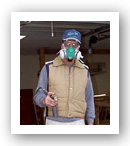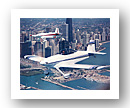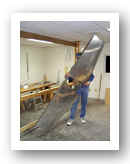
Sam Buchanan's RV6 project

RV Photo Album

RV Classifieds

Construction Tips
|
|
That Priming Thing...
It is tough to buck "conventional wisdom". This is true in most
endeavors, but conventional wisdom seems to occupy an especially hallowed space in the
homebuilt aircraft community. I have yet to see a topic debated (and misunderstood!) as
heavily as whether/what kind/how much primer to apply to our RV projects.
It appears that some builders are obsessed with fabricating the
"Eternal Aeroplane"! I really believe that some of the "expert"
builders would have newbies believe that their shiny new RVs are going to corrode,
crumble, and the resulting powder come wafting from the sky before the test flyoff is
complete if the "Proper" primer is not religiously applied.
Just how long do our RVs really have to last? I am building a thirty-year
aircraft. Thirty years from now, my flying days will almost certainly have been concluded
due to a health problem of some sort, and I really don't care much about the lifespan of
my RV beyond thirty years. Its cost will have been depreciated out by then, so resale
value thirty years from now is not a major concern to me. Besides, who wants to buy a
thirty-year-old homebuilt? Also, I don't know if it will even be legal or financially
feasible to fly these contraptions in thirty years! And besides that, think you will be
able to find a Lycoming in thirty years???
Most homebuilt aircraft do not live as long a life as factory built birds due to
construction inconsistency, lack of proper maintenance, and just sheer neglect from a
no-longer interested owner. True, the Vans series of airplanes have a better than average
chance of outliving most homebuilts due to their fine engineering and conventional
construction, but even they are not immune to eventual neglect.
So... how long does your RV need to last??
If you are intent on constructing a monument to the art of homebuilt aircraft
construction, then by all means, prime that airframe till the cows come home! No doubt,
several decades from now, our children will be leading their grandkids up to the museum
exhibit of your plane and all present will be awed by the wonderfully crafted but
humorously primitive state of aircraft back when the RV was in its heyday. Chuckles will
erupt as the oldsters recall airplanes with props, and the hilarious panel with its
collection of watch-like movements and primitive electronics will have heads wagging as
they wonder why anybody with time and money to spend would have expended so much care in
the preservation
of such antiquated technology.
Far out? Think about it. Does your RV really need to last sixty years? If so,
then prime that plane till the swallows come home.
I was looking through the repair manual of our 1940 J-3 the other day. In the section on
wing overhaul, it stated that all non-alclad parts should be primed. The inference was
that alclad parts were fine in their natural state.
I must admit that the "prime that sucker or watch it fall from the sky" syndrome
is a hard one to resist. Against my better judgment I primed the ribs of my RV6 the other
day, but I must admit, I felt really silly shooting perfectly good primer on the alclad
parts. However, I realize that not all (maybe very few?) builders share my thoughts, so I
have no intention of persuading anybody who is inclined to prime everything in sight from
doing just that. The biggest reason I shot the primer was just in case I wanted to sell
the plane in a few years. The prospective buyer may not be as much of a contrarian to
conventional wisdom as me.
I really do feel that a lot of folks are getting torqued out of shape over stuff that
should be resolved quickly and simply, and are generating much too much stomach acid about
building a 100 year airplane instead of just getting out in the shop AND BUILDING THE
THANG! Time wasted in wringing of hands over whether or not the plane will last for sixty
years could be better spent in banging some rivets.
After all........isn't the whole point of this exercise........to fly?

Sam Buchanan
Epilogue: The above article was written in late 1997 as I
was in the early stages of construction of N399SB. This update is being written
in early 2005 and the RV-6 now has over 600 hours and 5 1/2 years of reliable service.
Every time I have opened up the plane for routine service or a condition inspection, I
have been struck by the pristine condition of the interior skin surfaces. I have seen no
evidence of corrosion, not even any minor discoloration or dulling of the surface! The
plane is hangared and this no doubt has contributed to its excellent condition. But most
RV's are hangared, and I have no doubt my experience is the norm for most RV's.
Therefore, I feel even stronger now than seven years ago about the
questionable practice of priming everything is sight, especially when most of the popular
primers are not designed to be moisture-proof without a top coat. If building another RV,
none of the AlClad surfaces would be primed, and the non-AlClad material would receive
epoxy primer.
Update February 2020; The RV-6 is still
corrosion-free!
Working Smart Sam's thoughts on
how to get the maximum bang for your shop time
Why Build? Another editorial rant
by Sam
Back to Front Page |




